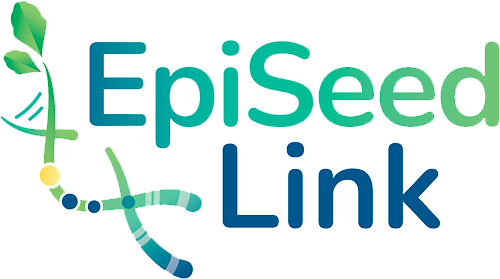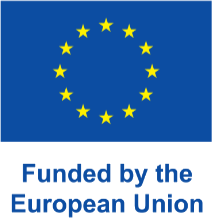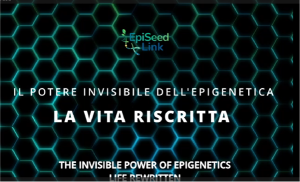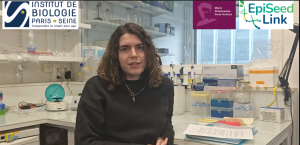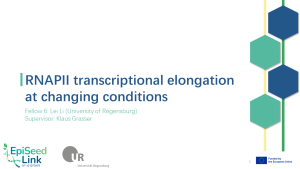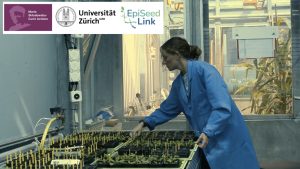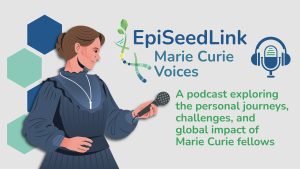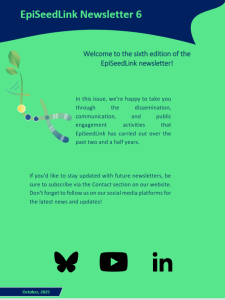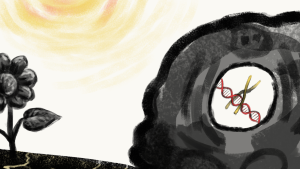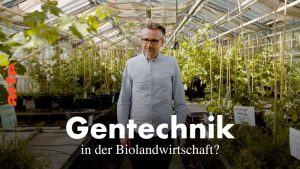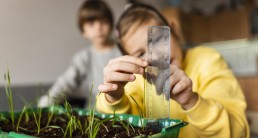Meet Our PhD Fellows: Sharing Their Passion for Science_5
Our EpiSeedLink PhD students are stepping in front of the camera to share their passion for science and give you a glimpse into their research within the project.
Training in Science Communication
As part of their training in science communication and public engagement, our EpiSeedLink PhD students are creating short videos to present their research and key scientific topics from the project.
Video Series
These videos will be posted every two weeks on EpiSeedLink’s social media channels, giving the public a front-row view of the research questions and discoveries of the next generation of scientists.
Fifth Video Spotlight- The invisible power of epigenetics: Life rewritten
The fifth video features Martina Curci PhD student at the Centro de Biotecnología y Genómica de Plantas (CBGP), who explores epigenetics through practical examples, showing how DNA works beyond the genetic code alone.
Did you know that our choices and environment can influence how our genes are expressed?
Learn about it by watching the video at this link
The video was recorded in Italian language with subtitles in English
You can watch all videos in our YouTube channel: https://www.youtube.com/@episeedlink2021/
Frontal Image designed by Freepik
Meet Our PhD Fellows: Sharing Their Passion for Science_4
Our EpiSeedLink PhD students are stepping in front of the camera to share their passion for science and give you a glimpse into their research within the project.
Training in Science Communication
As part of their training in science communication and public engagement, our EpiSeedLink PhD students are creating short videos to present their research and key scientific topics from the project.
Video Series
These videos will be posted every two weeks on EpiSeedLink’s social media channels, giving the public a front-row view of the research questions and discoveries of the next generation of scientists.
Fourth Video Spotlight
The fourth video features Clarisse Zigue PhD student at the Sorbonne University, who explores light priming in dark-adapted seedlings. She is interested in triggering the memory of dark-grown seedlings to help them cope better with the transition to light.
To characterise the acquisition of light memory, she is focusing on identifying the genes and pathways involved in this process.
Watch the video at this link
You can watch all videos in our YouTube channel: https://www.youtube.com/@episeedlink2021/
Frontal Image designed by Freepik
Seventh EpiSeedLink Newsletter
EpiSeedLink Newsletter 7 – Out Now!
We are pleased to announce the release of the seventh edition of the EpiSeedLink Newsletter.
This new issue showcases how the EpiSeedLink network has worked to make plant science and epigenetics accessible to both academic and non‑academic audiences. From international conferences and cutting‑edge workshops to training sessions and collaborative outreach, our project continues to bridge science and society.
What’s inside Newsletter 7?
✅ Updates on online and in‑person courses completed after February 2024
✅ Insights into the secondments carried out by our Fellows during 2025
✅ The launch of the EpiSeedLink Podcast, now available online
✅ Latest scientific publications from the consortium
Our mission remains clear: to share what we do, why it matters, and how EpiSeedLink contributes to advancing science and society.
Read the full Newsletter 7 here
Stay tuned for more updates as we continue the journey of EpiSeedLink!
If you would like to receive the EpiSeedLink Newsletter directly, please contact us at episeedlink@cnb.csic.es.
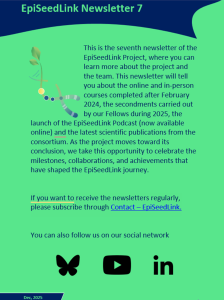
Frontal Image designed Freepik (<a href=”https://www.freepik.es/foto-gratis/papeles-blanco-paja-decorativa-mesa_3624218.htm”>Imagen de freepik</a>)
Meet Our PhD Fellows: Sharing Their Passion for Science_3
Our EpiSeedLink PhD students are stepping in front of the camera to share their passion for science and give you a glimpse into their research within the project.
Training in Science Communication
As part of their training in science communication and public engagement, our EpiSeedLink PhD students are creating short videos to present their research and key scientific topics from the project.
Video Series
These videos will be posted every two weeks on EpiSeedLink’s social media channels, giving the public a front-row view of the research questions and discoveries of the next generation of scientists.
Third Video Spotlight
The third video features Lei Li, PhD student at the University of Regensburg, who explores how environmental stress affects transcription elongation in Arabidopsis thaliana. While transcription initiation has long been considered the key regulatory step, new evidence highlights elongation as a major control point.
The study focuses on transcript elongation factors (TEFs) and their dynamic association with RNA polymerase II (RNAPII) under stress conditions like heat and salinity. By analyzing changes in the composition of the transcription elongation complex (TEC), the project aims to uncover how plants adjust gene expression to enhance stress resilience.
Watch the video at this link
You can watch all videos in our YouTube channel: https://www.youtube.com/@episeedlink2021/
Frontal Image designed Freepik
Meet Our PhD Fellows: Sharing Their Passion for Science_2
Our EpiSeedLink PhD students are stepping in front of the camera to share their passion for science and give you a glimpse into their research within the project
Training in Science Communication
As part of their training in science communication and public engagement, our EpiSeedLink PhD students are creating short videos to present their research and key scientific topics from the project.
Video Series
These videos will be posted every two weeks on EpiSeedLink’s social media channels, giving the public a front-row view of the research questions and discoveries of the next generation of scientists.
Second Video Spotlight
The second video features Shannon Skye Sherman, PhD student at the University of Zurich, who explores how seed priming reprograms molecular and epigenetic responses in Arabidopsis thaliana.
Seed priming, a pre-germination treatment, can enhance germination and tolerance to stresses such as drought.
By integrating transcriptomic and epigenetic changes associated with priming, she aims to identify mechanisms that may inform strategies for more resilient crops.
- Watch the video at this link
You can watch all videos in our YouTube channel: https://www.youtube.com/@episeedlink2021/
Frontal Image designed Freepik
EpiSeedLink – Marie Curie Voices: Podcast Series
️✨ We are excited to announce the launch of EpiSeedLink – Marie Curie Voices, a brand-new podcast series created by our talented Marie Skłodowska-Curie fellows!
This 5-episode series takes you behind the scenes of the MSCA experience, exploring the personal stories, challenges, and aspirations of young researchers shaping the future of science across Europe.
Episode 1 by Stefania Paltrinieri & Clarisse Zigue
In the first episode, Stefania and Clarisse share their inspiring journeys, including:
-
-
What motivated them to join the EpiSeedLink project
-
How the fellowship is transforming their careers
-
What being part of the Marie Curie community means to them
-
Watch Episode 1 on YouTube or Spotify
Why Listen?
Whether you are considering a research career or simply curious about life inside an MSCA project, this podcast offers a unique and inspiring perspective.
Stay tuned for the upcoming episodes to hear more¡
Sixth EpiSeedLink Newsletter
EpiSeedLink Newsletter 6 is Out Now!
We’re thrilled to share the latest edition of the EpiSeedLink Newsletter, showcasing the dissemination, communication, and public engagement activities carried out over the past two and a half years.
From international conferences and cutting-edge workshops to training sessions and collaborative outreach across Europe and beyond, our network is working to make plant science and epigenetics accessible to both academic and non-academic audiences.
In this issue:
-
▶️ Over 80 dissemination activities by our PIs and fellows
-
▶️ Highlights from national and international conferences
-
▶️ Updates on our communication channels: website, YouTube, LinkedIn, and Bluesky
-
▶️ Insights into our efforts to engage society with science
Our mission is simple: to share what we do, why it matters, and how EpiSeedLink contributes to advancing science and society.
Curious about how science meets society? Want to explore the impact of our outreach and collaborations across Europe?
Read the full newsletter here
We hope you enjoy reading it as much as we enjoyed putting it together.
Check it out and stay tuned for more updates from the EpiSeedLink project!
If you want to receive the EpiSeedLink Newsletter, please send a message to episeedlink@cnb.csic.es.
Frontal Image designed Freepik (<a href=”https://www.freepik.es/foto-gratis/papeles-blanco-paja-decorativa-mesa_3624218.htm”>Imagen de freepik</a>)
Meet Our PhD Fellows: Sharing Their Passion for Science_1
Our EpiSeedLink PhD students are stepping in front of the camera to share their passion for science and give you a glimpse into their research within the project
Training in Science Communication
As part of their training in science communication and public engagement, our EpiSeedLink PhD students are creating short videos to present their research and key scientific topics from the project.
Video Series
These videos will be posted every two weeks on EpiSeedLink’s social media channels, giving the public a front-row view of the research questions and discoveries of the next generation of scientists.
First Video Spotlight
The first video features Maira Marins Dourado, PhD student at the University of Amsterdam, who explores:
“Identifying cis-regulatory elements associated with drought stress in canola”
You can watch all videos in our YouTube channel: https://www.youtube.com/@episeedlink2021/
Frontal Image designed Freepik
EpiSeedLink PhD Students Interview on ARTE TV
EpiSeedLink PhD Students Featured on ARTE TV
We are delighted to share the contribution of three of our PhD students, Kingsley Onyinye Ibeabuchi, Shreyas Padmanabha Sharma Beedubail, and Martina Curci to the ARTE TV program “Agree to Disagree”, which explored the timely question: “Genetic engineering in organic farming?”.
The program openly discusses about genetic engineering from two points of view and how EpiSeedLink investigates alternative and more sustainable solutions.
One of the topics was Seed Priming and its pivotal role in promoting organic farming, while safeguarding both farmers’ livelihoods and the environment. The discussion focused on biostimulant-based seed priming, a cutting-edge technology designed to boost seed vigor even under abiotic stress conditions. This innovative approach holds great promise for both the seed industry and farmers.
You can watch the full program here:
The recording took place during Martina’s and Shreyas’ secondments to Deutsche Saatveredelung AG (DSV), where they had the chance to reflect on the two contrasting perspectives presented in the debate. Their participation highlighted how EpiSeedLink’s research can offer innovative solutions for more sustainable agriculture.
EpiSeedLink (MSCA-DN-2021) is dedicated to transforming this vision into reality and paving new paths in research for enhancing sustainability.
The complete interview is available on the YouTube channel of the Franco-German broadcaster ARTEde. (www.arte.tv)
EpiSeedLink Seed Germination Kit
EpiSeedLink Seed Germination Kit – Inspiring the Next Generation of Scientists!
EpiSeedLink Fellows have developed a Seed Germination Kit as part of the Public Engagement training delivered by Cell EXPLORERS. Moreover, Dr. Sara Farrona, an EpiSeedLink supervisor, has guided and supported them throughout the process.
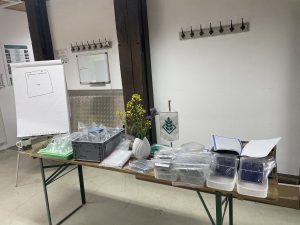
On June 27th, 2025, some of the EpiSeedlink members (Dr. Ulf Feuerstein and Kingsley Onyinye Ibeabuchi), who belonged to Deutsche Saatveredelung AG (DSV) in Asendorf (Germany), had the pleasure of welcoming around 32 enthusiastic 10–11-year-old students for an EpiSeedLink Seed Germination kit demonstration. The event was a fantastic opportunity to introduce young minds to plant science in a hands-on and engaging way.

The sessions were held in German, and we were very grateful to have Dr. Ulf Feuerstein (EpiSeedLink supervisor) supporting with translations from English, as well as Katharina, who is currently doing her master’s thesis at DSV, helping to guide the children through the content in German.
 The highlight? The children were fascinated by the visible effects of salt stress and seed priming, demonstrated using carefully prepared sample plates. Even more exciting: each child prepared their own plates to take home, so they could continue observing and measuring changes themselves!
The highlight? The children were fascinated by the visible effects of salt stress and seed priming, demonstrated using carefully prepared sample plates. Even more exciting: each child prepared their own plates to take home, so they could continue observing and measuring changes themselves!
 They ran three 45-minute sessions with small groups (10–12 kids each). After a tight first round, the format was adjusted for smoother flow in the later sessions. While some concepts, especially data analysis and seed priming, were a bit complex for this age group, the curiosity and excitement from the children made it all worthwhile.
They ran three 45-minute sessions with small groups (10–12 kids each). After a tight first round, the format was adjusted for smoother flow in the later sessions. While some concepts, especially data analysis and seed priming, were a bit complex for this age group, the curiosity and excitement from the children made it all worthwhile.
A big thank you to everyone who made this outreach activity possible! ✨
Let’s keep sparking scientific curiosity, one seed at a time.

Fronted image by <a href="https://www.freepik.es/foto-gratis/vista-frontal-nina-midiendo-brotes-que-crecen-casa_12246951.htm">Imagen de freepik</a>
